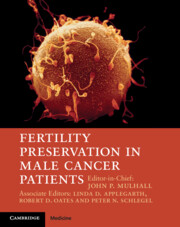16 results
Chapter 14 - Inheritance and Male Fertility
- from Section 2 - Clinical Evaluation of the Infertile Male
-
-
- Book:
- Infertility in the Male
- Published online:
- 08 July 2023
- Print publication:
- 15 June 2023, pp 237-252
-
- Chapter
- Export citation

Fertility Preservation in Male Cancer Patients
-
- Published online:
- 05 March 2013
- Print publication:
- 21 February 2013
Section 2 - Disorders of male fertility
-
- Book:
- Fertility Preservation in Male Cancer Patients
- Published online:
- 05 March 2013
- Print publication:
- 21 February 2013, pp 39-103
-
- Chapter
- Export citation
Section 5 - Post-therapy considerations
-
- Book:
- Fertility Preservation in Male Cancer Patients
- Published online:
- 05 March 2013
- Print publication:
- 21 February 2013, pp 282-343
-
- Chapter
- Export citation
7 - Azoospermia
- from Section 2 - Disorders of male fertility
-
-
- Book:
- Fertility Preservation in Male Cancer Patients
- Published online:
- 05 March 2013
- Print publication:
- 21 February 2013, pp 58-63
-
- Chapter
- Export citation
Section 1 - Anatomy and physiology
-
- Book:
- Fertility Preservation in Male Cancer Patients
- Published online:
- 05 March 2013
- Print publication:
- 21 February 2013, pp 1-38
-
- Chapter
- Export citation
Fertility Preservation in Male Cancer Patients - Half title page
-
- Book:
- Fertility Preservation in Male Cancer Patients
- Published online:
- 05 March 2013
- Print publication:
- 21 February 2013, pp i-ii
-
- Chapter
- Export citation
Section 4 - Preservation strategies
-
- Book:
- Fertility Preservation in Male Cancer Patients
- Published online:
- 05 March 2013
- Print publication:
- 21 February 2013, pp 172-281
-
- Chapter
- Export citation
Index
-
- Book:
- Fertility Preservation in Male Cancer Patients
- Published online:
- 05 March 2013
- Print publication:
- 21 February 2013, pp 344-353
-
- Chapter
- Export citation
Section 3 - Impact of cancers and treatment on male fertility
-
- Book:
- Fertility Preservation in Male Cancer Patients
- Published online:
- 05 March 2013
- Print publication:
- 21 February 2013, pp 104-171
-
- Chapter
- Export citation
Copyright page
-
- Book:
- Fertility Preservation in Male Cancer Patients
- Published online:
- 05 March 2013
- Print publication:
- 21 February 2013, pp iv-iv
-
- Chapter
- Export citation
Fertility Preservation in Male Cancer Patients - Title page
-
-
- Book:
- Fertility Preservation in Male Cancer Patients
- Published online:
- 05 March 2013
- Print publication:
- 21 February 2013, pp iii-iii
-
- Chapter
- Export citation
Contributors
-
-
- Book:
- Fertility Preservation in Male Cancer Patients
- Published online:
- 05 March 2013
- Print publication:
- 21 February 2013, pp vii-x
-
- Chapter
- Export citation
Contents
-
- Book:
- Fertility Preservation in Male Cancer Patients
- Published online:
- 05 March 2013
- Print publication:
- 21 February 2013, pp v-vi
-
- Chapter
- Export citation
Contributors
-
-
- Book:
- Infertility in the Male
- Published online:
- 19 May 2010
- Print publication:
- 24 September 2009, pp vii-x
-
- Chapter
- Export citation
Chapter 15 - Genetic aspects of infertility
-
-
- Book:
- Infertility in the Male
- Published online:
- 19 May 2010
- Print publication:
- 24 September 2009, pp 251-276
-
- Chapter
- Export citation



